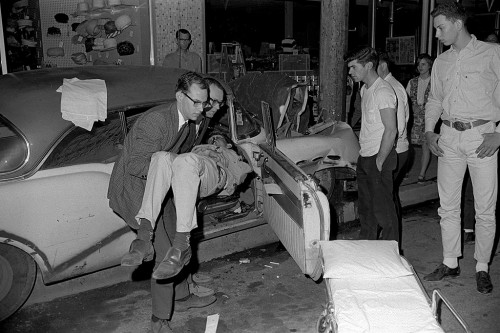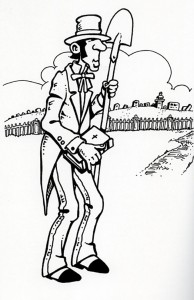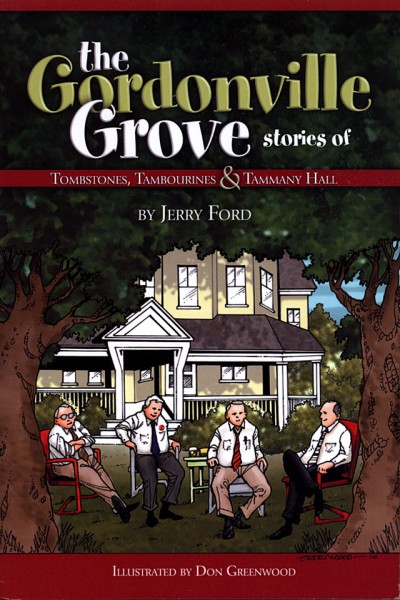My old high school campaign manager, Bill Hopkins, said I needed to read Jerry Ford’s new book, The Gordonville Grove: Tombstones, Tambourines, & Tammany Hall. I didn’t know if Bill really liked the book or if Jerry was giving him a cut of the sales, but I headed over to Amazon anyway. The book arrived in the mail this morning and I knocked it off in a couple of hours.
Jerry was a few years older than my crowd, so I knew him by name, but not really in person. His family ran Ford & Sons Funeral Home, so I mostly knew him from chasing his ambulances.
Funeral homes provided ambulances
See, back before cities got fancy, it was customary for funeral homes to run to wrecks and other unfortunate happenings because they were about the only folks who had a vehicle large enough to carry a patient.
 John Carpenter, left, and Walter Joe Ford remove Dale Smith from a car in which he was a passenger when it struck a pole in front of the Montgomery Ward store on Main St. in 1966. Smith had a broken jaw. John “Doc” Carpenter eventually became Cape County Coroner. Even though he was from Sikeston, he and I were good buddies from Scouts and debate. As early as his teens, Doc said he wanted to work in the funeral industry. He died of colon cancer in 2000. Walter Joe Ford, was author Jerry Ford’s older brother.
John Carpenter, left, and Walter Joe Ford remove Dale Smith from a car in which he was a passenger when it struck a pole in front of the Montgomery Ward store on Main St. in 1966. Smith had a broken jaw. John “Doc” Carpenter eventually became Cape County Coroner. Even though he was from Sikeston, he and I were good buddies from Scouts and debate. As early as his teens, Doc said he wanted to work in the funeral industry. He died of colon cancer in 2000. Walter Joe Ford, was author Jerry Ford’s older brother.
“Swoop and scoop”
I was on a rescue squad in North Carolina with some guys who used to work for funeral homes doing ambulance work. “Tell me, Red,” I asked one of them. “Isn’t in the best interest of the funeral home for the guest of honor to arrive not alive at the hospital? Were you ever told to take it slow on the way to the E.R.?”
Red, a linthead from one of the town’s dying textile mills thought for a while (they always had to pause to figure out what to say, me bein’ a Yankee and all), then replied, “There was always two schools of thought about that.”
“Most folks would let the funeral home that picked up the body keep it, but there was always the danger that your competitor might pick up one of the survivors and sell him a funeral on the way to the hospital. I was always of the ‘swoop and scoop’ school, myself.”
Jerry Ford’s book illustrated by Don Greenwood
 Cape artist Don Greenwood illustrated the book. I’ve been a fan of his for years, particularly after he was kind enough to let me use one of his illustrations for my bike blog logo.
Cape artist Don Greenwood illustrated the book. I’ve been a fan of his for years, particularly after he was kind enough to let me use one of his illustrations for my bike blog logo.
Gordonville Grove may not be for everyone. You almost have to be from the area to appreciate many of his stories. On the other hand, I found myself putting names to some the characters he left nameless to protect the not-so-innocent.
I may have to steal the disclaimer in the front of the book: “The opinions herein are solely those of the author. …cannot warrant any of the information in this book and can make no guarantees as to the accuracy of the situations and dialogue expressed. Certain physical characteristics and other descriptive details in this book may have been embellished for the sake of storytelling.”
Integration comes to the funeral business
The chapter titled The Deal made the whole purchase of the book worthwhile. I learned something I had never known about Cape.
 Up until the mid-60s, no white funeral home had ever buried a black person in a traditional funeral setting, Ford writes. The only exceptions were one or two private burials of domestic workers employed by some of Cape’s wealthiest families. Sparks Funeral Home was the only option for most blacks.
Up until the mid-60s, no white funeral home had ever buried a black person in a traditional funeral setting, Ford writes. The only exceptions were one or two private burials of domestic workers employed by some of Cape’s wealthiest families. Sparks Funeral Home was the only option for most blacks.
At the request of a respected member of the black community, Jerry’s father agreed to see if the color barrier could be broken.
The funeral industry is fiercely competitive, but all of the local funeral directors brokered a deal: the first black family that wanted a funeral in one of their establishments could pick the one they wanted. After that, all of the homes would go into a rotation so that no one establishment would suffer the “stigma” of dealing with blacks.
As it turned out, it was a non-issue. Cape Girardeans had no apparent problems with formerly white funeral homes holding black funerals.
Jerry Ford’s swing band
Jerry’s Ford’s 13-piece swing band has played throughout the Midwest for over 50 years. He writes about playing in all of the local clubs like The Purple Crackle and The Colony Club.
He’s performed with or watched most of the big names of the era: Henry James, Harry Ranch, Woody Herman and his Thundering Herd, The Blue Rhythm Boys, Bob Sisco and Jack Stalcup.
The Fords, the Limbaughs and the Rusts
The Fords, Limbaugh and the Rust families were the big political movers and shakers in the Cape community. The Fords were Democrats, and the latter two were Republicans. Jerry writes about how politicians from the different parties could work together for the common good without the partisan gridlock we see today.
Ordering the book(s)
- The Gordonville Grill.
- Dreamers, his latest book.

